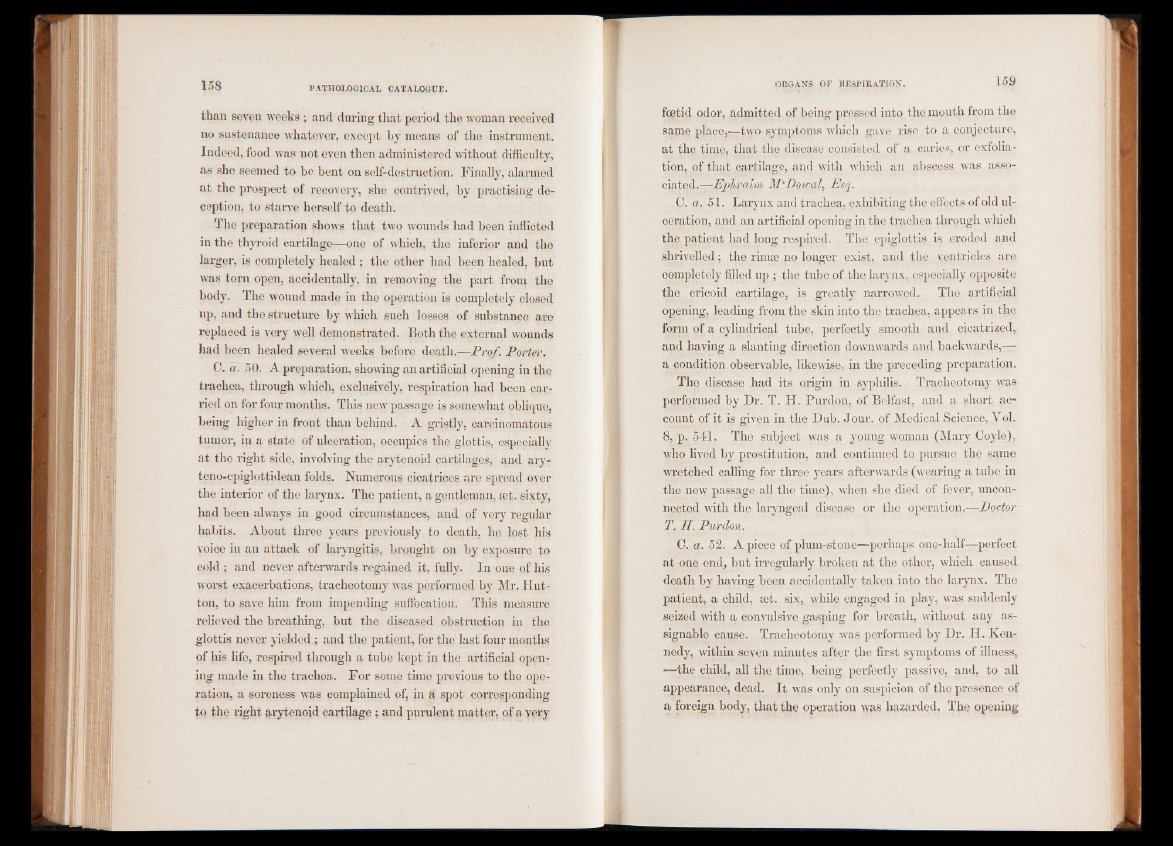
than seven weeks ; and during that period the woman received
no sustenance whatever, except by means of the instrument.
Indeed, food was not even then administered without difficulty,
as she seemed to be bent on self-destruction. Finally, alarmed
at the prospect of recovery, she contrived, by practising deception,
to starve herself to death.
The preparation shows that two wounds had been inflicted
in the thyroid cartilage—one of which, the inferior and the
larger, is completely healed ; the other had been healed, but
was torn open, accidentally, in removing the part from the
body. The wound made in the operation is completely closed
up, and the structure by which such losses of substance are
replaced is very well demonstrated. Both the external wounds
had been healed several weeks before death.—Prof. Porter.
0. a. 50. A preparation, showing an artificial opening in the
trachea, through which, exclusively, respiration had been carried
on for four months. This new passage is somewhat oblique,
being higher in front than behind. A gristly, carcinomatous
tumor, in a state of ulceration, occupies the glottis, especially
at the right side, involving the arytenoid cartilages, and ary-
teno-epiglottidean folds. Numerous cicatrices are spread over
the interior of the larynx. The patient, a gentleman, set. sixty,
had been always in good circumstances, and of very regular
habits. About three years previously to death, he lost his
voice in an attack of laryngitis, brought on by exposure to
cold; and never afterwards regained it, fully. In one of his
worst exacerbations, tracheotomy was performed by Mr. Hutton,
to save him from impending suffocation. This measure
relieved the breathing, but the diseased obstruction in the
glottis never yielded.; and the patient, for the last four months
of his life, respired through a tube kept in the artificial opening
made in the trachea. For some time previous to the operation,
a soreness was complained of, in a spot corresponding
to the right arytenoid cartilage ; and purulent matter, of a yery
foetid odor, admitted of being pressed into the mouth from the
same placed—two symptoms which gave rise to a conjecture,
at the time, that the disease consisted of a caries, or exfoliation,
of that cartilage, and with which an abscess was associated.—
Ephraim M‘Dowal, Esq.
0. a. 51. Larynx and trachea, exhibiting the effects of old ulceration,
and an artificial opening in the trachea through which
the patient had long respired. The epiglottis is eroded and
shrivelled; the rimse no longer exist, and the ventricles are
completely filled up ; the tube of the larynx, especially opposite
the cricoid cartilage, is greatly narrowed. The artificial
opening, leading from the skin into the trachea, appears in the
form of a cylindrical tube, perfectly smooth and cicatrized,
and having a slanting direction downwards and backwards,—
a condition observable, likewise, in the preceding preparation.
The disease had its origin in syphilis. Tracheotomy was
performed by Dr. T. H. Purdon, of Belfast, and a short account
of it is given in the Dub. Jour, of Medical Science, Yol.
8, p. 541. The subject was a young woman (Mary Coyle),
who lived by prostitution, and continued to pursue the same
wretched calling for three years afterwards (wearing a tube in
the new passage all the time), when she died of fever, unconnected
with the laryngeal disease or the operation.—Doctor
T. H. Purdon.
C. a. 52. A piece of plum-stone—perhaps one-half—perfect
at one end, but irregularly broken at the other, which caused
death by having been accidentally taken into the larynx. The
patient, a child, set. six, while engaged in play, was suddenly
seized with a convulsive gasping for breath, without any assignable
cause. Tracheotomy was performed by Dr. H. Kennedy,
within seven minutes after the first symptoms of illness,
—the child, all the time, being perfectly passive, and, to all
appearance, dead. It was only on suspicion of the presence of
a foreign body, that the operation was hazarded. The opening